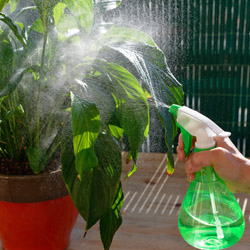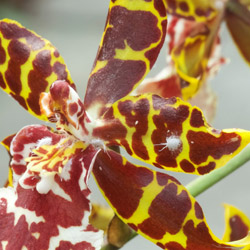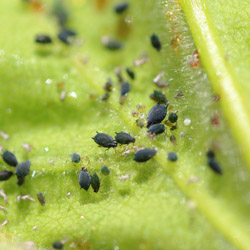It’s not unusual or a sign of failure if houseplants become infested with some common potted plant pests. This problem is more pervasive when introducing newly purchased plants to the home, moving tender houseplants from the outdoors back inside with the changing seasons, and finally, when houseplants are under stress. These buggers can wreak havoc, leaving plants unhappy, unhealthy, and downright unattractive. However, even the most tenacious pests can be controlled with conscientious care. By acting quickly when these unwanted guests are first noticed, you can completely remove an infestation and keep your houseplants healthy, happy, and thriving.
Top 5 Common Houseplant Pests and Controlling Them
There are quite a number of houseplant pests that can make both you and your plants miserable. We’ve covered the five most common ones in this article.
Fungus Gnats
These tiny, flying pests, resembling fruit flies, don’t harm houseplants in their mature, adult form, but fungus gnat larvae live in houseplant soil and feed on organic material. This not only robs the plant of nutrition, but the larvae may also nibble on the plant’s roots. While they don’t cause much overall damage to an otherwise healthy plant, fungus gnats can be very irritating when they form cloud-like flocks hovering around a plant’s foliage.
Overwatering encourages fungus gnats, and they can be notoriously difficult to eradicate. Begin control by repotting the plant in fresh potting soil. Before repotting, rinse the roots to wash away any larvae. If reusing the same container, be sure to sterilize it before repotting. Use a high-quality, well-draining potting mix. Once repotted, reduce the amount of water and frequency, allowing the top inch of the soil to dry between waterings. Bottom watering will also make the environment less attractive to fungus gnats. In addition, mixing diatomaceous earth into the potting soil, adding a layer of chicken grit to the soil surface, or applying Bt var. israelensis (Bti-H14) will all help to control fungus gnat larvae organically.
Mealybugs
The tell-tale sign of these tiny, sap-sucking insects is a white, waxy, cottony substance frequently found on the underside of plant leaves and in plant stem crotches. As they suck the plant’s sap, the leaves wither and wilt. Yellowing leaves can also indicate an infestation, mainly if leaves are seen throughout the plant rather than just older bottom foliage.
When a houseplant is heavily infested with mealybugs, the fastest way to control the pests is to prune away infected foliage and prudently discard it. If the infestation is light, the bugs can be deterred first with a strong stream of water followed by an application of Neem oil. Rubbing alcohol is also an effective control measure. Apply the alcohol directly to the pests with a cotton swab or ball soaked in alcohol. Regardless of the control method used, immature mealybugs can be easily missed. Keep an eye out and retreat the plant as necessary.
Spider Mites
These pests are very destructive to all houseplants and can be challenging to get rid of. The mites themselves are so tiny that they may not be noticeable even with a heavy infestation, but their webs on the undersides of foliage or stretching between stems are easier to see. Leaves that show yellow stippling may also indicate an infestation.
Spider mites thrive in dry conditions, so keeping houseplants’ humidity high is an excellent way to deter them. Running a humidifier, frequent misting, grouping pots, and sitting pots on a water-filled pebble tray are all helpful solutions. When the bugs are present, neem oil spray should be used weekly to remove them and keep them from returning. Alternatively, light cleaning with insecticidal soap is also an effective way to control spider mites.
Aphids
While better known for their outdoor infestations, aphids can also be a problem for indoor houseplants. They are tiny insects, no more than one-eighth of an inch in size, and range from green or black to reddish or white. They are plump insects and get that way as they suck sap from the plant, usually on the foliage or stems. The plant will gradually wilt as it is unable to stay firmly upright while the aphids drain its sap.
Aphids are easily dislodged with a blast of water, so a cleansing shower is an excellent way to remove them without any unnecessary chemicals. If the infestation is extreme, washing the plant gently with an insecticidal soap may be necessary. Neem oil spray can also be effective for controlling aphids on houseplants.
Scale
These insects have a hard, oval-shaped shell that gives them a tough, scale-like exterior as they line up on a plant’s stems in tight clusters, similar to barnacles on a boat’s hull. These pests suck sap from the plant and then produce a sticky, honeydew residue that can coat the plant and lead to mildew or may attract additional pests.
Your first line of defense is gently scraping scale bugs off with your fingernail, taking care not to scratch or damage the already stressed plant. Dabbing the insects with a cotton swab or ball soaked in rubbing alcohol or spraying with neem oil can also be effective.
Minimizing Houseplant Pests
No matter which pests present a problem, it’s always best to avoid infestations altogether rather than try to control them after the insects have already appeared. To minimize the risk of bugs taking over your houseplants…
- Purchase new plants only from a reputable retailer like Dammann’s Garden Center & Greenhouse. We offer pest-free houseplants, effective plant care products, and the support you may need to identify and combat pest problems.
- Scrutinize new plants before purchasing and avoid plants with signs of pests.
- Quarantine any new plant for at least a week to ensure it has no unwanted guests, including outdoor summer plants that will overwinter as houseplants.
- Use high-quality, well-drained potting soil for all houseplants rather than garden soil that isn’t sterilized and can harbor pests.
- Provide houseplants with optimum care so they are not stressed, as this can make them more susceptible to pest infestations.
- Sterilize all houseplant equipment regularly, including pots that will be reused, pruners and shears, and watering cans, to be sure no pests are carried between plants.
- Stay alert at all times for signs of possible insect infestations. The faster you act, the easier it will be to control these houseplant pests.
Finding pests on your houseplants can be frustrating or downright frightening, but don’t worry; with careful monitoring, appropriate control measures, and Dammann’s Garden Center & Greenhouse in your corner, your plants will soon be pest-free.








